
In
mathematics
Mathematics is a field of study that discovers and organizes methods, Mathematical theory, theories and theorems that are developed and Mathematical proof, proved for the needs of empirical sciences and mathematics itself. There are many ar ...
, given a
group ''G'', a ''G''-module is an
abelian group ''M'' on which ''G''
acts compatibly with the abelian group structure on ''M''. This widely applicable notion generalizes that of a
representation of ''G''.
Group (co)homology provides an important set of tools for studying general ''G''-modules.
The term ''G''-module is also used for the more general notion of an
''R''-module on which ''G'' acts linearly (i.e. as a group of ''R''-module
automorphism
In mathematics, an automorphism is an isomorphism from a mathematical object to itself. It is, in some sense, a symmetry of the object, and a way of mapping the object to itself while preserving all of its structure. The set of all automorphism ...
s).
Definition and basics
Let
be a group. A left
-module consists of an abelian group
together with a
left group action such that
:
for all
and
in
and all
in
, where
denotes
. A right
-module is defined similarly. Given a left
-module
, it can be turned into a right
-module by defining
.
A
function is called a morphism of
-modules (or a
-linear map, or a
-homomorphism) if
is both a
group homomorphism
In mathematics, given two groups, (''G'',∗) and (''H'', ·), a group homomorphism from (''G'',∗) to (''H'', ·) is a function ''h'' : ''G'' → ''H'' such that for all ''u'' and ''v'' in ''G'' it holds that
: h(u*v) = h(u) \cdot h(v)
whe ...
and
-
equivariant.
The collection of left (respectively right)
-modules and their morphisms form an
abelian category
In mathematics, an abelian category is a category in which morphisms and objects can be added and in which kernels and cokernels exist and have desirable properties.
The motivating prototypical example of an abelian category is the category o ...
(resp.
). The category
(resp.
) can be identified with the category of left (resp. right)
-modules, i.e. with the
modules over the
group ring
 In
In  In
In